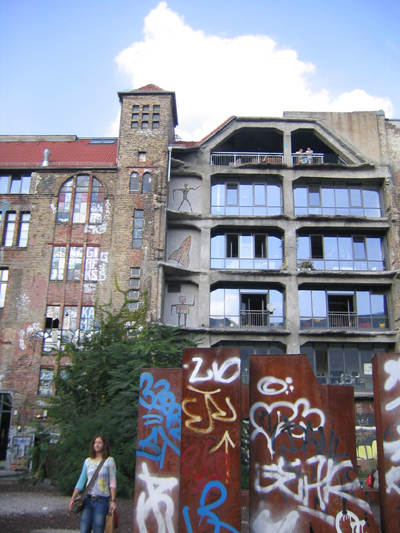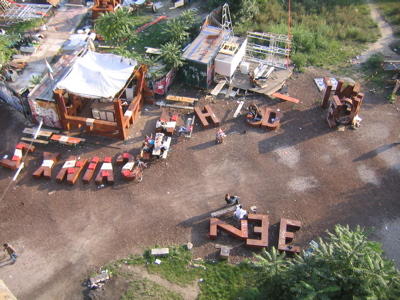 Kunsthaus Tacheles, just blocks from where the Berlin Wall once stood, now houses a vibrant international arts community. View from the rear.
Kunsthaus Tacheles, just blocks from where the Berlin Wall once stood, now houses a vibrant international arts community. View from the rear.Berlin's Oranienburger Strasse is a curious street. Definitely in a hip part of town, it's dotted with high-end shoe stores, new glass-front condos, sidewalk bistros, and stores that sell exorbitantly priced handbags and women's jeans. A restaurant we noticed seemed to epitomize the neighborhood: surrounded by palm trees (in Berlin?), an open-air dining area has been covered by a canopy of red beach umbrellas. Underneath, tiki torches illuminate a half dozen or so stone Buddha statues from Thailand and cafe tables where a diverse, good-looking, and obviously fashion-conscious bunch of diners titter in hushed tones over what I can only guess are expensive meals. Despite this razzle-dazzle, we were drawn across the street by a big white sign with black letters spelling "Kunsthalle."
 Interior view of a main stairway. Despite graffiti-plastered windows, the artist-policed space has cleaner bathrooms than most rock clubs I've been to.
Interior view of a main stairway. Despite graffiti-plastered windows, the artist-policed space has cleaner bathrooms than most rock clubs I've been to.We'd stumbled upon Berlin's not-so-secret art squat, Kunsthaus Tacheles. A building with a storied history—it started out as a kind of proto-shopping mall in the early 1900s, was taken over first by the Nazis, then by the Communists. And when the Berlin Wall, once located just a few blocks away, came down, the building became the home to a host of German and international artists, many the sons and daughters of Communist revolutionaries from Cuba, the Soviet Union, and China. Today, the building has the outward appearance of disuse—a bomb-pitted facade of gray stone covered with graffiti, stencil art, and stickers, and windows darkened from the inside by more graffiti. But inside is a vibrant, diverse, anarchistic (i.e. leaderless) art community. The building hosts a cinema, a performing arts space, 30 studios (made available to artists, who are selected by an outside curatorial panel, for only the cost of utilities), two indoor and two outdoor bars, exhibition spaces, two galleries facing Oranianburger Strasse, and a high-power projector that screens video art on an adjacent building every night of the week. Artists from Japan, China, the Middle East, and the UK, among other places, curently occupy the studios; probably Tacheles' most famous tenant is recording artist Peaches, who's been there for two years.
 The Offenbar on the top floor offers a distant view of the Berliner Dom. It's name ("open bar") comes not from free booze—damn.—but from the fact that windows blown out in World War II were never replaced.
The Offenbar on the top floor offers a distant view of the Berliner Dom. It's name ("open bar") comes not from free booze—damn.—but from the fact that windows blown out in World War II were never replaced.Tacheles is a Jewish word that roughly translates to "speak truth." Martin Reiter, an Austrian artist who's been a part of the community since 1994, told me that the name was first used by a punk band that rehearsed in the space, but, given its proximity to Berlin's main Jewish neighborhood and the activist views of many of its artists, it seemed a fitting name for an autonymous art community.
 The Offenbar overlooks an outdoor space that includes makeshift bars, seating made from rusty signage letters, a ping pong table, and a tent village set up by a master African carver.
The Offenbar overlooks an outdoor space that includes makeshift bars, seating made from rusty signage letters, a ping pong table, and a tent village set up by a master African carver.But, as I first approached the building, I have to admit I was skeptical of its autonomy. With so many trendy restaurants and new buildings as its neighbors, how independent could these artists really be? Were they just maintaining enough edge to keep the tiki-hut diners intrigued, just trying to create the illusion of danger that fuels so much of commerce? The more I heard from Reiter, a frizzy-haired painter, robot-maker, and video artist, the more suprised I was at just how autonymous the house is. As he tells it, the building was close to being demolished in the early '90s, so close that holes were bored to place dynamite. But artist-squatters intervened, physically, to prevent its destruction. After the wall fell, the neighborhood, like much of the city, was in chaos. Residents of East Berlin were pouring into the west, power companies had no idea where their grids extended and how to serve so many new citizens. Which all gave Tacheles' artists free reign. For four years, the house had free water and electricity, unbeknownst to the city.
 Martin Reiter in the Offenbar
Martin Reiter in the OffenbarOver the years, Tacheles and the city have managed a kind of peace: the city of Berlin, realizing that the art house has stablized and lead to the gentrification of the neighborhood, let it be and have even funded it at times. Tacheles is extremely involved in land-use issues in the neighborhood and tries to be a good citizen. Today, Tacheles is a non-profit organization, pays no rent, and its building has been designated a historic landmark, so it can't be destroyed. It's far from Utopia, Reiter says, since factions within the house have different visions for it, but the model—a delicate balance between anarchy and civic-engagement, pragmatisim and dreaming, culture and commerce—is definitely one to admire. And the fact that it's situated in Germany's highest rent neighborhood, alternative culture pressed face to face with commercial enterprise, makes it all the more sweet.
4 comments:
A nice post, but, a Jewish word?
So I'm told. Click on the history section of their site and scroll down to the English translation for more.
Ah. It was just a bad translation. The German section actually says (I think):
"Tacheles is Yiddish and means to speak in plain language, to manifest, to explain yourself, or to tell someone your opinion; in Hebrew, it means to pursue a goal, to come true, or to get to the heart of something."
I went to tacheles with a German friend who could only interprit it as this...."when my dad used to really shout at me for doing something bad as a teenager, my mum used to say what he was saying was Tacheles...like thats is it...no argument...no comeback"
Post a Comment